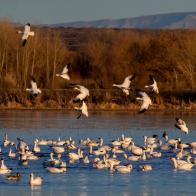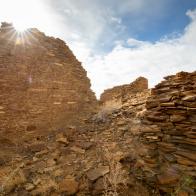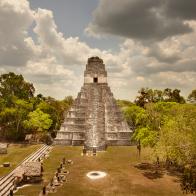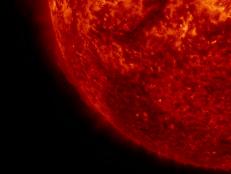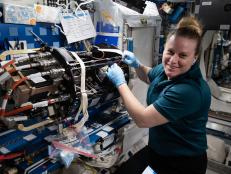All Space Articles
Showing 31 - 45 of 491 results
How Do We Know How Old the Sun Is?
Scientists estimate that our Sun is about 4.57 billion years old. They’re surprisingly confident about that number, too, which opens up an immediate question: how do we know that? The short answer is “a lot of science and math”, but I have a feeling you’re not here for the short answer.
Mars is Getting International
Things are getting a little crowded at the red planet.
NASA is using Navajo Language to Name Rocks and Soil on Mars
NASA’s Perseverance team is working in tandem with the Navajo Nation to use their native language in defining rocks and soil found on Mars. 50 words have been approved to name these landmarks.
How Astronomers Use a Trick of Gravity to See the Most Distant Objects in the Universe
Let’s say you’re an astronomer (work with me here) and you want to take a picture of something incredibly, deeply far away. You know, the typical business of astronomy.
NASA's New Rocket is Taller than the Statue of Liberty
The massive space launch system was unveiled last week. Following successful completion of upcoming simulation tests, NASA will set a date for the first of the Artemis II lunar missions.
A Guide to this August’s Best Astronomy Attractions
Learn more about the exciting things happening in the night sky this month! From the rings of Saturn to the most popular meteor shower of the year, August 2022 has us stargazing all month.
It’s the Edge of Space for Virgin Galactic
On May 22, Virgin Galactic’s first human spaceflight successfully launched into space from Spaceport America, New Mexico. Mothership, VMS Eve, the carrier and launch platform for the VSS Unity SpaceShipTwo spacecraft, carried VSS Unity to 44,000 feet in the air and then released it as the spaceship began a rocket powered flight to the edge of space.
Richard Branson of Virgin Galactic Successfully Travels to Space
On Sunday, July 11, around 11:30A ET, Richard Branson, the founder of Virgin Galactic, soared to the edge of space as a passenger aboard Virgin Galactic’s VSS Unity. The space plane then landed safely at Spaceport America in New Mexico, making Branson's space tourism dream come true.
NASA Has Announced Plans for the Next Decade of Space Missions, And It’s Awesome
Personally speaking, I feel like we’ve been focusing on Mars a little bit too much recently. Sure, the Red Planet is all sorts of awesome – so awesome it may have once been a home for life – but with more than half a dozen orbiters, landers, and rovers, it’s certainly got its due.
How Exoplanets Became the Next Big Thing in Astronomy
To date, we know of over 5,000 planets outside the solar system. And astronomers suspect that there may be *checks notes* around a trillion more in our galaxy alone. The search for exoplanets is one of the hottest topics in astronomy, with expensive telescopes and giant collaborations all searching for the holy grail of the 21st century: an Earth 2.0, a habitable world like our own.
Expedition 64 to Return Home on April 17
After 185 days in space aboard the ISS, NASA astronaut Kate Rubins, Roscosmos cosmonaut Sergey Ryzhikov, and Roscosmos cosmonaut Sergey Kud-Sverchkov are coming home. They are scheduled to land back on Earth in their Soyuz MS-17 spacecraft at 12:56A EDT on Saturday, April 17.
Meet Ingenuity: NASA’s First Mars Helicopter
Perseverance with Ingenuity strapped to its belly launched on July 30, 2020, from Cape Canaveral Air Force Station in Florida. The Mars Rover and Mars Helicopter safely landed on the dusty surface at 3:55P ET on February 18, 2021, after traveling nearly 292.5 million miles.
South Korea Joins Space Race by Sending its First Spacecraft to the Moon
South Korea is launching its first lunar probe to the moon on August 4th. The Korea Pathfinder Lunar Orbiter (KPLO) or Danuri, developed by the Korea Aerospace Research Institute (KARI) is being launched to study moon carters, magnetic fields, and surface weathering.
Liftoff of NASA and SpaceX Crew-2!
The NASA and SpaceX Crew-2 mission launched on Friday, April 23 at 5:49A ET from the NASA Launch Complex 39A. This historic milestone marks the second operational mission of SpaceX’s Crew Dragon. Onboard was NASA astronaut Shane Kimbrough, NASA astronaut Megan McArthur, ESA astronaut Thomas Pesquet, and JAXA astronaut Akihiko Hoshide. After a 23-hour journey, Crew-2 successfully docked with the International Space Station (ISS) on April 24 at 5:08A ET. Here's everything that happened from launch day to the Crew-2's arrival at the ISS. (Updated April 24, 2021)
Countdown to Launch: NASA and SpaceX Crew-2 Mission
Liftoff set for Friday, April 23, at 5:49A EDT marks the second operational flight of SpaceX’s Crew Dragon. Four space explorers are heading to the International Space Station for a six-month stay. It will take them 23 hours to reach their destination.






















